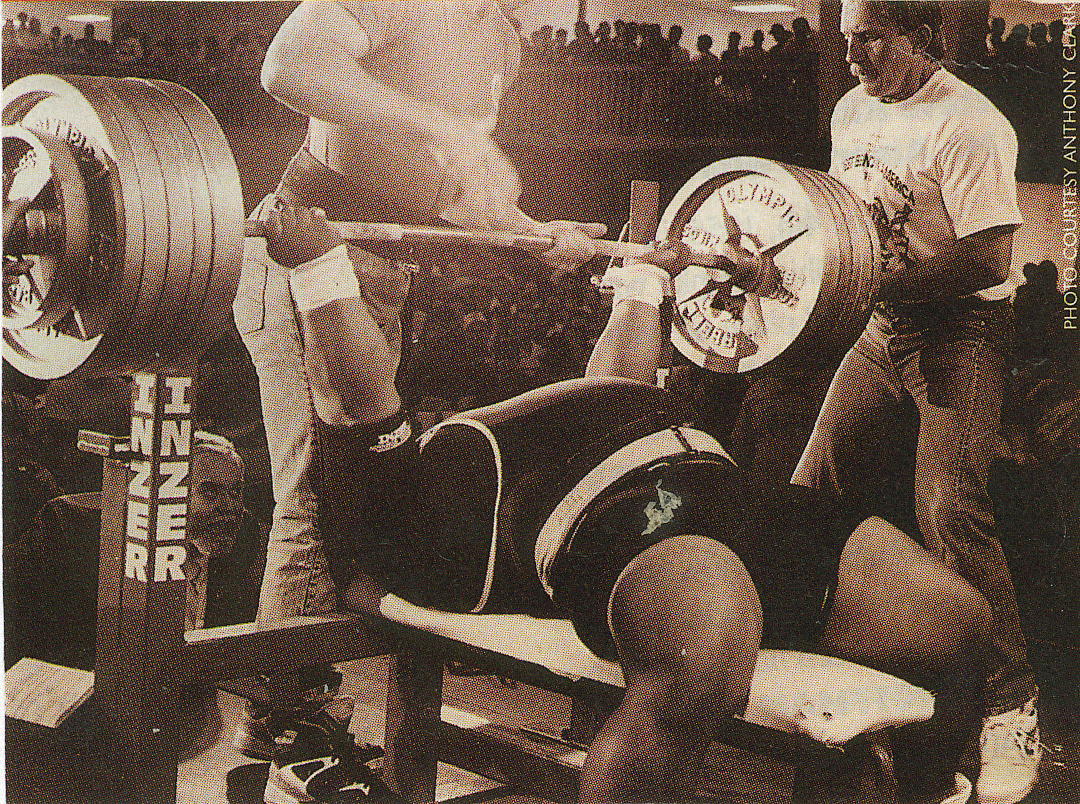Anthony Clark
There are a lot of assistance exercises available, some productive, some not so productive. One assistance exercise that may have benefits is the reverse grip bench press. Simply put, the reverse grip bench is a bench press with your grip going the opposite way - that is, knuckles facing your feet. I first heard of this exercise in Muscle & Fitness. There was a picture of the famous Paul Brothers, the Barbarians, doing reverse grips.
They put on exhibitions and routinely reverse grip bench over 500 pounds. At first, I considered the exercise a novelty. Later, 275'er Bill Nichols told me in an interview that after Rick Weil suggested he add them to his bench training, his max bench went up when no other technique seemed to work. Lately, Anthony Clark has been benching massive weights in competition using a reverse grip. I am not suggesting using the reverse grip at a meet, but I am suggesting we may have something here.
This exercise greatly changes the leverage as well as the involvement of the pressing muscles. The contribution of the pectorals is reduced and the triceps and delts increased. The stabilizing musculature is stressed in a different manner. I have always believed that in order to successfully lift a weight, you must first stabilize and control that weight. The increased stabilizing strength could flow over to your competition bench.
Before we look at how the reverse grip bench may be used in your training, let's first discuss its proper execution. As you can imagine, the feel of this lift is extremely different, and care should be taken before proceeding into heavy weights.
First of all, spotters are absolutely necessary. If the weight falls, it tends to fall towards your head and neck area which could spell disaster. Have your spotter lift the weight for you. Another suggestion is to get close to the bench racks. For normal benches, this is not desirable, but for safety concerns, both during liftoff and actual lifting, it is desirable to get close to the rack.
The trajectory of the lift tends to go straight up as opposed to the bar path of a normal bench which goes towards the head and rack. You will not bump the rack and it will be easier to get the bar both off the rack into position and back on the rack after.
The most logical safety step is to start out light. You have to get used to the unique feel of the exercise. Confidence in controlling the weight must be built. As with all new exercises, if you start too heavy too soon, you risk injury as the muscles are not used to the demands.
You can also do reverse benches inside a power rack for greater safety. Use the "with thumb" grip. The thumbless grip would create a greater risk of the bar falling out of your hand and onto your face.
There are many ways to integrate the reverse grip bench into your routine. I regard it as a substitute for close grip benches. Since both of these exercises decrease the pectoral involvement in favor of the delts and triceps, there is no need to perform both of these in the same workout. The exercise is great for lifters with triceps deficiencies. The triceps really get a workout, especially if you concentrate on keeping your elbows tucked into the body.
You could do a few sets of reverses after your regular benches, or do reverses only on your second bench day to the exclusion of regular benches. If your bench press has stalled in a rut, try reverses as your assistance move of choice. You can also experiment with various grip widths. I would not go narrower than shoulder width grip or wider than your regular bench grip.
The number of reps are up to you. Have them coincide with where you are in your cycle.
Chris Confessore once suggested a novel way of doing reverse grips on a machine. Eagle offers a seated bench machine that would enable the lifter to do a seated reverse grip bench with a higher degree of safety. Other manufacturers may offer similar stations for this variation. This is particularly valuable if you don't have a spotter or the confidence to do barbell reverse benches. I wouldn't suggest using dumbbells, as control of these may be too precarious.
As with any assistance exercise, the end goal is to improve in the powerlift targeted. Also, don't go overboard and overtrain by doing too many sets of reverse grips and other assistance work.
You may even find that, like Anthony Clark, you excel in reverse grips over regular benches and use this style in competition. Give reverse grips a try, but remember the cautions I outlined here.


No comments:
Post a Comment